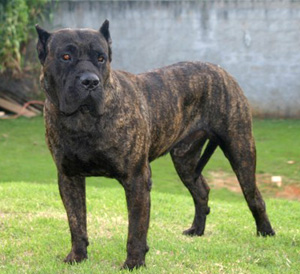
Perro de Presa Canario
Height:
– Males: 23 to 26 inches
– Females: 22 to 25 inches
Weight:
– Males: Min weight is 100 lbs
– Females: Min weight is 85 lbs
Also Known As: Dogo Canario; Canary Dog

Photo credit: Tamaran Bull Kennel
CLICK HERE to View Breeder Listings
Breed Profile
The ancestors of the Perro de Presa Canario are believed to have been brought to the Canary Island by the Spanish Conquistadors at the beginning of the 15th century. These ancestors of the breed were used to guard farms, herd and hold cattle, as well as to hunt wild or stray dogs. The breed’s numbers began to decline by the 1940s, however, renewed interest in preserving the breed was seen in the early 1970s when a breed club was established.
The Presa Canario is a powerfully built dog with a massive head giving an overall impression of an imposing and intimidating guard dog. The breed is courageous and agile enabling him to do the work he was initially bred for: to drive and hold cattle as well as to protect his home and family. The Presa is also very affectionate, calm, docile, subdued, devoted, loyal and eager to please in the home and with his family. He is, however, suspicious of strangers and known to be aggressive with other dogs.
In order to maintain his muscular physique, he does require a fair amount of outdoor exercise and is best suited for country living.
The Presa’s single coat is short, flat, harsh in texture and comes in any shade of fawn, black and brindle in any combination of these colours. He wears a black or dark brown mask on the face that does not extend over the eyes and he may or may not have a white blaze or patch on the head.
Health Issues
If you are considering the adoption of a Perro de Presa Canario puppy, or any breed, it is very important to be selective in choosing a responsible and reputable breeder. Ensure that the prospective puppy’s parents have all health clearances. Breeding of any dog should not be done until after they have been proven to be free of evidence of significant hereditary diseases. (For more information on selecting a breeder, see the articles on the main General Information page.)
Additional Health Resources:
- Health and Nutrition — Growing section of the Canada’s Guide to Dogs website which includes information on several health and nutrition related issues.
- Canine Health Information Center (CHIC) — Providing a source of health information for owners, breeders, and scientists that will assist in breeding healthy dogs. CHIC is a centralized canine health database jointly sponsored by the AKC/Canine Health Foundation (AKC/CHF) and the Orthopedic Foundation for Animals (OFA).
- AKC Canine Health Foundation — Working towards developing scientific advances in canine health.
- Canine Eye Registration Foundation (CERF)
- Orthopedic Foundation for Animals (OFA)
- Ontario Veterinary College (OVC)
- University of Pennsylvania Hip Improvement Program (PennHip)
- HealthGene — HealthGene Corporation is the leading provider of veterinary DNA diagnostic services in Canada.
- Labgenvet — Laboratory of Veterinary Genetics is a Canadian diagnostic laboratory that offers a comprehensive service of DNA tests for veterinary genetic diseases.
Breed Standards
- UKC Breed Standard
- FCI Standard No. 346 – Dogo Canario
- The Perro de Presa Canario is not currently recognized by the Canadian Kennel Club and is accepted for recording in the American Kennel Club Foundation Stock Service program and assigned to the Working Dogs group.
Grooming Information
- Grooming — This section of the Canada’s Guide to Dogs website includes tips, articles and information covering all aspects of dog grooming along with a listing of Groomers from across Canada.
Training Resources
The Perro de Presa Canario is not recommended for the first time dog owner. Owner confidence is very important as well as early socialization and obedience training.
- Training — For training information, see this growing section of the Canada’s Guide to Dogs website for tips, articles, as well as listings of training centres across Canada.
Additional Information
- Clubs, Sports & Activities — For information on the many sports and activities you can get involved in with your dog.
- Working Dogs — The Working Dogs section of the Canada’s Guide to Dogs website provides information and listings of organizations that are involved in various dog jobs, such as Guide Dogs, Therapy Dogs, Police Dogs, Protection Dogs, and much more.
Breed Listing
*NOTE 1: CHIC – The Canine Health Information Center “is a database of consolidated health screening results from multiple sources. Co-sponsored by the Orthopedic Foundation for Animals (OFA) and the American Kennel Club (AKC) Canine Health Foundation, CHIC works with parent clubs to identify health screening protocols appropriate for individual breeds. Dogs tested in accordance with the parent club established requirements, that have their results registered and made available in the public domain are issued CHIC numbers.” To learn more, visit: www.caninehealthinfo.org
*NOTE 2: The Fédération Cynologique International (FCI) is the World Canine Organization, which includes 91 members and contract partners (one member per country) that each issue their own pedigrees and train their own judges. The FCI recognizes 344 breeds, with each being the “property” of a specific country. The “owner” countries write the standards of these breeds in co-operation with the Standards and Scientific Commissions of the FCI, and the translation and updating are carried out by the FCI. The FCI is not a breed registry nor does it issue pedigrees.
Quick Links
Get In Touch
- Email: canadasguidetodogs@gmail.com
- Email: info@canadasguidetodogs.com
- Visit us on Facebook: www.facebook.com/CanadasGuideToDogs
— CanadasGuideToDogs.com is an Amazon Associate as well as a participant in various affiliate programs, as such fees are earned from qualifying purchases.
